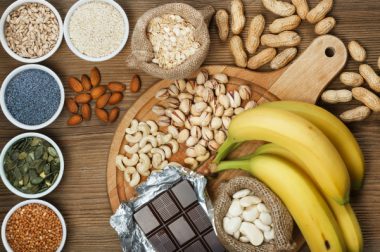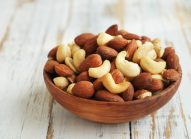- Magnesium is an essential mineral for the body
- More than half is found in bones and teeth
- It contributes to the transmission of nerve impulses
- Vegetables are the main sources of magnesium
- Tiredness is one of the signs of magnesium deficiency
- It reduces cramps and protects the heart
Why should we
eat some daily?
Although 2/3 of magnesium is found in the skeleton, it is not there to be stored away for later use by the body. Magnesium found in bones acts as a buffer for magnesium in the bloodstream, maintaining an adequate level of magnesium outside of the cells. It is therefore important to have a sufficient magnesium intake daily, as this subtle balance is key for the proper functioning of over 300 metabolic reactions in the body.
What is
its role?
Magnesium is the first line of defense against tiredness. This impact is explained in part by its crucial role in the body’s energy production. Magnesium also plays a part in nerve transmission and muscle contraction, both vital processes for cardiac function and muscle relaxation. This last property also enables it to relieve cramps (during pregnancy and after physical exertion, for example).
Magnesium also contributes to protein synthesis, healthy teeth and bones, and cell division. Finally, it promotes the proper operation of psychological functions (memory, language, intelligence, attention, etc.), which can partly explain its well-known anti-stress effect.
What is the
recommended intake?

Where is
it found?
Magnesium is a significant component of chlorophyll, the green pigment of plants. It is not surprising, then, that it is present in large quantities in vegetables with dark green leaves. On average, fruits and vegetables alone are responsible for almost a fourth of the intake. It is also found in non-negligible quantities in pulses, nuts, dried fruits, bananas, chocolate, and whole grains. Refined grains (white bread, white rice, etc.) have a lower magnesium content because most of it is in the seed coat, called bran, which is removed during processing.
Magnesium content
in food
| Magnesium content in food | mg/100g |
| Cocoa powder | 520 |
| Cooked common periwinkles | 300 |
| Cashews, almonds, cooked common whelks | 250 |
| Peanuts, walnuts, hazelnuts | 160-180 |
| Cooked Brussels sprouts, chocolate bars, purslane, cooked sorrel | 100-120 |
| Cooked Swiss chard, whole wheat bread | 80-85 |
| Cooked shrimps, cooked mussels, dried figs, chocolate milk, dried dates, raw spinach | 60-75 |
| Chickpeas, dried apricots, Comté cheese, cooked white beans, scallops, mackerel, cooked red kidney beans, arugula, cooked spinach, Parmesan, emmental cheese, oysters, brown rice, canned flageolet beans | 40-55 |
| Parsley, dandelions, chestnuts, raw black radishes, cardoons, cooked lentils, cooked artichokes | 30-40 |
| Source: Ciqual |
Did you know? Some types of mineral water have a significant magnesium content. Read the labels carefully!
Preconceived notions
about magnesium
Magnesium only rarely causes urinary tract stones. In most cases, magnesium plays more of a preventive role. It increases the solubility of calcium, especially in urine. It also reduces the intestinal absorption of oxalate, a substance which contributes to forming stones.
What are
its particularities?

The problems with magnesium are its many interactions that can create a state of deficiency in spite of sufficient dietary intake. Taking certain medications (such as certain “water pills” and antibiotics), manganese, potassium, or oral contraceptives increases the loss of magnesium. Alcohol abuse and certain diseases (Crohn’s disease, celiac disease) reduce the intestinal absorption of magnesium.
What if I eat
too much or too little?
The first signs of magnesium deficit are mainly physical and intellectual tiredness, loss of appetite, and weakness. In the case of a more serious deficiency, effects include cramps and numbness as well as various neuromuscular hyperexcitability disorders, especially the ones which affect the heart (cardiac arrhythmia).
Magnesium is found in foods that have been left by the wayside in modern diets. This is why it is important to go back to eating more vegetables, dried fruits, and grains.



 Peas
Peas  Bean sprouts
Bean sprouts  Vegetable garden: growing chicory
Vegetable garden: growing chicory 













